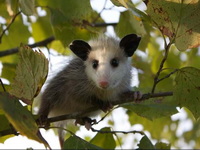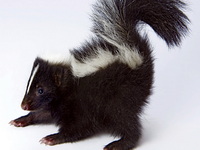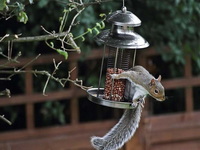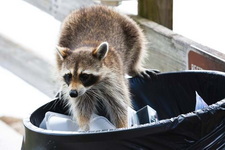
Opossum

Skunk

Squirrel

Raccoon
Raccoons, Opossums, Wildlife
They may seem cute and cuddly when you see them in the great outdoors but the reality of a wild animal is very different up close and personal, as many have discovered after encountering wildlife in their home or surrounding structures. Wild animals can defend themselves and are very aggressive when confronted, especially when they’re already stressed in a new environment.
Common pest-proofing techniques can help keep out wildlife pests as well as insect pests, but you should take several simple precautions to be sure your home is not attractive to wildlife. Opossums and raccoons can be attracted to garbage, so keeping trash in sealed bags and disposing of it regularly will reduce the chance that pests raid your garage or garbage cans. Cutting tree limbs back from your roofline helps prevent squirrels from getting access to the attic.
Invasions from local wildlife tend to be more of an issue in the late fall and winter months as the animals search for a place to stay warm. Feces in the attic or garage, strange odors and scurrying sounds in the walls, displaced siding can all be indicators that you have an unwelcome guest in your home. Here is a guide to Missouri’s most common critters that bother homeowners.
Raccoons
Raccoons have a distinctive appearance with their ‘bandit masks’ and ringed tails. They generally prefer to live in heavily forested areas close to a water source, but they can be found almost anywhere. They build dens in hollow trees, brush piles, barns and abandoned buildings, and for the unlucky homeowner they can also make use of chimneys, attics, and hollow areas beneath porches. Raccoons are a serious threat to your property. They damage homes, sometimes severely, when they try gain access through attics or chimneys and they can even tear off shingles and siding. They are clever, powerful, problem solving animals and anyone who’s had to protect their garbage cans from pillaging raccoons can attest to that fact.
Raccoons are generally not a threat to a human unless cornered or rabid. Raccoons are major hosts of rabies, and some indicators that a raccoon may be rabid include foaming at the mouth, stiff legs, unprovoked aggression or foaming at the mouth. They may have watery eyes and make very loud and unusual noises. Needless to say, a rabid raccoon must be avoided at any cost. Homeowners are well advised to call us to deal with a raccoon problem rather than take it on yourself, as there is some danger involved.
Skunks
There are two species of skunks in Missouri: the striped skunk and the eastern spotted skunk. Striped skunks are more common and are found throughout the state. They are black with two white stripes running down their back. Striped skunks are about 20-30 inches long and weigh 2-11 pounds. Eastern spotted skunks are smaller and less common than striped skunks. They are black with white spots all over their body. Eastern spotted skunks are about 14-22 inches long and weigh 3/4-2-3/4 pounds. Both striped and eastern spotted skunks are nocturnal and eat a variety of insects, small mammals, and fruit. Skunks are also known for their ability to spray a foul-smelling odor as a defense mechanism.
Skunks are generally docile animals and will leave you alone as long as you return the favor, but if they feel threatened they will spray. The spray has a VERY strong musky odor and is very difficult to remove. If you come upon a skunk, give it plenty of room. In addition to the noxious spray, skunks are also susceptible to rabies. Skunks become a problem for people when they start digging around decks or around the foundation of your home.
There are a few things you can do to reduce the chances of ever having a skunk issue. Make sure any food sources are removed or securely locked away. This includes pet food, garbage cans, rotting fruit etc. Seal up any points of possible access to your structure. If you still have a skunk problem that you can’t resolve, call us.
Opossums
Opossums have a rat-like appearance and reach the size of an average housecat, about 15 lbs. Appearances to the contrary, Opossums are actually mild mannered, very clean animals that pose no threat to humans. They become pests when they try to set up residence in your attic or garage. An opossum may hiss when approached but will rarely bite. This doesn’t mean that you can casually pick one up. They can serve as a vector for several diseases and are also a host for fleas, ticks, mites, and lice that can be transmitted to family pets. On the whole, opossums do more good for your yard than harm but if they do become a problem, they should be humanely trapped and relocated rather than killed.
Squirrels
The most common squirrels in Missouri are the Eastern Fox Squirrel and the Eastern Grey Squirrel. Most Missourians enjoy their presence and they are welcome visitors in both urban and rural settins. Conflicts with humans can arise, however. Because squirrels are rodents, they constantly chew to wear down their always-growing incisor teeth, and they can damage wooden decks, exterior siding, fencing, and electrical wiring. Squirrels sometimes gnaw into the attics of homes, causing water and structural damage, and damage to electrical wiring. Squirrels can also be a pest around bird feeders, scattering the seed and scaring the birds away.
You can exclude squirrels and other wildlife from buildings by closing all openings with half-inch wire mesh, taking care to ensure that no squirrels are trapped inside because additional damage will result when the animal chews its way out. If young may be present, delay repairs until the young have matured and exited. If you’re having problems with squirrels at your bird feeder, the best solution is to simply provide them with an alternate food source. Scatter prepared squirrel food on the ground or hang up a corn cob from a tree.
Contact us for an inspection if you’re having issues with your local wildlife. We can provide immediate remediation and exclusion and also prepare a plan for you to keep squirrels from becoming an issue in the future.